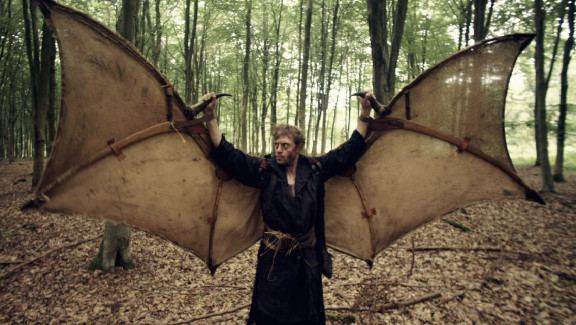 | ||
Eilmer of Malmesbury (also known as Oliver due to a scribe's miscopying, or Elmer) was an 11th-century English Benedictine monk best known for his early attempt at a gliding flight using wings.
Contents
Life
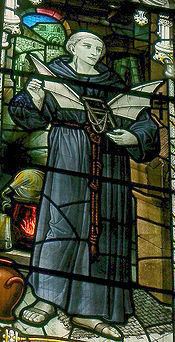
Eilmer was a monk of Malmesbury Abbey and is known to have written on astrology. All that is known of him is told in the Gesta regum Anglorum (Deeds of the English Kings), written by the eminent medieval historian William of Malmesbury in about 1125. Being a fellow monk of the same abbey, William almost certainly obtained his account directly from people who knew Eilmer himself when he was an old man.
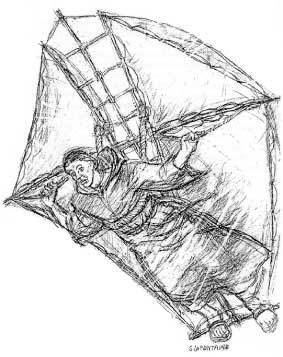
Later scholars, such as the American historian of technology Lynn White, have attempted to estimate Eilmer's date of birth based on a quotation in William's Deeds in regard to Halley's Comet, which appeared in 1066. The difficulty lies in that William recorded what Eilmer said not to establish his age, but to show that his prophecy was fulfilled later that year when the Normans invaded England.
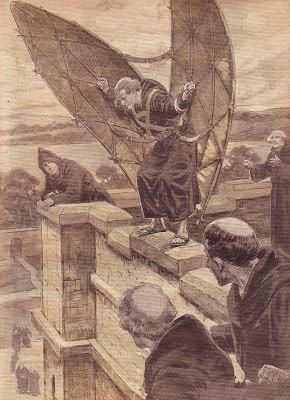
You've come, have you? – You've come, you source of tears to many mothers. It is long since I saw you; but as I see you now you are much more terrible, for I see you brandishing the downfall of my country.
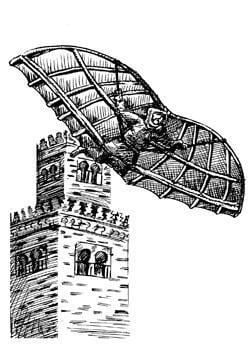
If Eilmer had seen Halley's comet seventy-six years earlier in 989, he could have been born about 984, making him about five or six years old when he first saw the comet, old enough to remember it. However the periodicity of comets was probably unknown in Eilmer's time, and so his remark "It is long since I saw you" could have referred to a different, later comet. Since it is known that Eilmer was an "old man" in 1066, and that he had made the flight attempt "in his youth", the event is placed some time during the early 11th century, perhaps in its first decade.
The flight
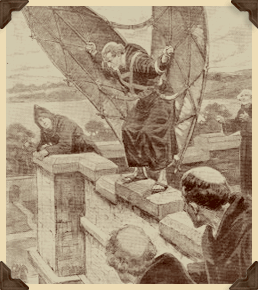
William records that, in Eilmer's youth, he had read and believed the Greek fable of Daedalus. Thus, Eilmer fixed wings to his hands and feet and launched himself from the top of a tower at Malmesbury Abbey:

He was a man learned for those times, of ripe old age, and in his early youth had hazarded a deed of remarkable boldness. He had by some means, I scarcely know what, fastened wings to his hands and feet so that, mistaking fable for truth, he might fly like Daedalus, and, collecting the breeze upon the summit of a tower, flew for more than a furlong [201 metres]. But agitated by the violence of the wind and the swirling of air, as well as by the awareness of his rash attempt, he fell, broke both his legs and was lame ever after. He used to relate as the cause of his failure, his forgetting to provide himself a tail.

Given the geography of the abbey, his landing site, and the account of his flight, to travel for "more than a furlong" (220 yards, 201 metres) he would have had to have been airborne for about 15 seconds. His exact flightpath is not known, nor how long he was in the air, because today’s abbey is not the abbey of the 11th century, when it was probably smaller, although the tower was probably close to the present height. "Olivers Lane", off the present-day High Street and about 200 metres (660 ft) from the abbey, is reputed locally to be the site where Eilmer landed. That would have taken him over many buildings. Maxwell Woosnam's study concluded that he is more likely to have descended the steep hill off to the southwest of the abbey, rather than the town centre to the south.
Flight analysis
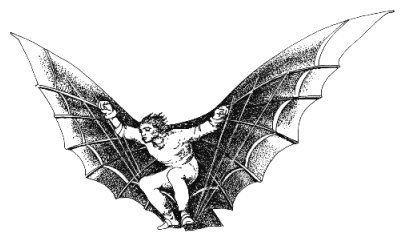
To perform the manoeuvre of gliding downward against the breeze, utilizing both gravity and the wind, Eilmer employed an apparatus somewhat resembling a gliding bird. However being unable to balance himself forward and backwards, as does a bird by slight movements of its wings, head and legs, he would have needed a large tail to maintain equilibrium. Eilmer could not have achieved true soaring flight in any event, but he might have glided down in safety if he had had a tail. Afterwards, Eilmer remarked that the cause of his crash was that "he had forgotten to provide himself with a tail."
Historical traditions and influence
Other than William's account of the flight, nothing has survived of Eilmer's lifetime work as a monk, although his astrological treatises apparently still circulated as late as the 16th century.
Based on William's account, the story of Eilmer's flight has been retold many times through the centuries by scholars, encyclopaedists, and proponents of man-powered flight, keeping the idea of human flight alive. These include over the years: Helinand of Froidmont (before 1229), Alberic of Trois-Fontaines (before 1241), Vincent of Beauvais (1250s), Roger Bacon (c. 1260), Ranulf Higden (before 1352, and the first to misname him "Oliver") and the English translators of his work, Henry Knighton (before 1367), John Nauclerus of Tübingen (c. 1500), John Wilkins (1648), John Milton (1670), and John Wise (1850).
More recently, Maxwell Woosnam in 1986 examined in more detail the technical aspects such as materials, glider angles, and wind effects.
Eilmer typified the inquisitive spirit of medieval enthusiasts who developed small drawstring toy helicopters, windmills, and sophisticated sails for boats. In addition, church artists increasingly showed angels with ever more accurate depictions of bird-like wings, detailing the wing's camber (curvature) that would prove beneficial to generating the lifting forces enabling a bird – or an aeroplane – to fly. This climate of thought led to a general acceptance that air was something that could be "worked." Flying was thus not magical, but could be attained by physical effort and human reasoning. However, although Eilmer seems to have been an inquisitive individual and a keen stargazer, his scientific observation of the heavens would have been coloured by a distinctly medieval awareness of the cosmos and the position of humans therein. As a monk located in Malmesbury Abbey in the eleventh century, he would not have been ignorant of the need to guard and stabilize the soul for its flight in the afterlife; the differences between angelic and human bodies; the weight of sin and the unnaturalness of ascending mortal flesh.
Legacy
The School of Mechanical and Mining Engineering at the University of Queensland in Brisbane, Australia has developed a Computational Fluid Dynamics simulation code named Eilmer3.
